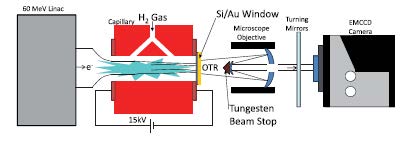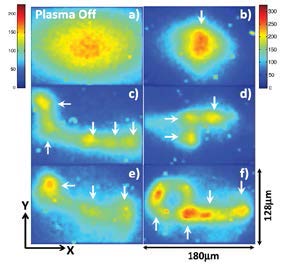- Home
- Capabilities
- Science Highlights
- Operations
- Publications
-
ES&H
- Experiment Start-up
- Laser Safety
Collider-Accelerator Dept.
- C-AD ES&H Resources
- Staff
- Users' Place
- Apply for Access
Current Filamentation Instability
Relativistic particle beams propagating in plasmas are subject to current filamentation instability (CFI) that breaks the beam into narrow, high current density filaments. The occurrence of CFI was postulated in the context of laser driven, plasma-based accelerators. However, the basic features of this instability, including the transition from single to multiple filaments and the scaling of the filament’s size with plasma density had not been studied nor the transverse imaging of the filaments shown. The ATF experiment (see figure) provided, for the first time, observation of multiple beam filaments resulting from CFI of a well-controlled accelerator electron beam propagating in plasmas at various densities.

Figure 1. Experimental setup: Electron bunch from a 60 MeV linac is focused at the entrance to the capillary discharge. The OTR pattern is collected and magnified by a microscope’s objective on the ECCD camera.

Figure 2. OTR images of the bunch at the capillary exit with arrows indicating filaments.
Experimenters have demonstrated that, as is inherent to instability, the number and size of the filaments vary from event to event. However, as theoretically expected, multiple filaments are observed only when the radius of the transverse bunch is large compared to the depth of the cold plasma collisionless skin; and at reduced bunch densities CFI does not occur. These results are critically important for understanding processes in PWFA, fast ignition, and cosmology.
Allen, B., et al., Experimental Study of Current Filamentation Instability. Phys. Rev. Lett., 2012. 109(18): p. 185007




